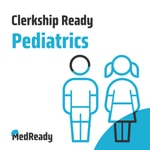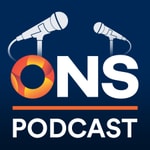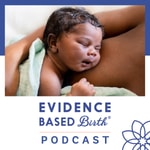Clerkship Ready: Pediatrics – Détails, épisodes et analyse
Détails du podcast
Informations techniques et générales issues du flux RSS du podcast.

Clerkship Ready: Pediatrics
MedReady
Fréquence : 1 épisode/27j. Total Éps: 34

Classements récents
Dernières positions dans les classements Apple Podcasts et Spotify.
Apple Podcasts
🇨🇦 Canada - medicine
25/07/2025#90🇨🇦 Canada - medicine
25/11/2024#92🇨🇦 Canada - medicine
24/11/2024#60🇨🇦 Canada - medicine
23/11/2024#81🇨🇦 Canada - medicine
07/11/2024#67🇨🇦 Canada - medicine
06/11/2024#59🇨🇦 Canada - medicine
05/11/2024#70🇨🇦 Canada - medicine
03/11/2024#72🇨🇦 Canada - medicine
27/10/2024#87🇨🇦 Canada - medicine
04/10/2024#99
Spotify
Aucun classement récent disponible
Liens partagés entre épisodes et podcasts
Liens présents dans les descriptions d'épisodes et autres podcasts les utilisant également.
See all- https://doi.org/
46 partages
- https://www.bedsider.org/
13 partages
Qualité et score du flux RSS
Évaluation technique de la qualité et de la structure du flux RSS.
See allScore global : 73%
Historique des publications
Répartition mensuelle des publications d'épisodes au fil des années.
Before You See a Pediatric Patient with Sore Throat
Saison 1 · Épisode 32
jeudi 5 septembre 2024 • Durée 15:35
Listen along as we dive into the many causes of sore throat. Learn about the common causes such as allergies and viral illnesses while also what to do when a child with epiglottitis comes in. We will cover CENTOR criteria as well and when you should think about Group A strep testing.
Common Causes
- Viral Presentation
- HSV
- Mononucleosis
- Allergic Presentation
- Group A Strep
- CENTOR Criteria
Emergency Causes
- Peritonsillar Abscess
- Retropharyngeal Abscess
- Epiglottitis
Wrap Up & Conclusion
Resources/Links:
https://www.chop.edu/conditions-diseases/throat-anatomy-and-physiology
https://www.mdcalc.com/calc/104/centor-score-modified-mcisaac-strep-pharyngitis
References
- Aluma Chovel-Sella, Amir Ben Tov, Einat Lahav, Orna Mor, Hagit Rudich, Gideon Paret, Shimon Reif; Incidence of Rash After Amoxicillin Treatment in Children With Infectious Mononucleosis. Pediatrics May 2013; 131 (5): e1424–e1427. 10.1542/peds.2012-1575
- Becker JA, Smith JA. Return to play after infectious mononucleosis. Sports Health. 2014 May;6(3):232-8. doi: 10.1177/1941738114521984. PMID: 24790693; PMCID: PMC4000473.
- Chowdhury MDS, Koziatek CA, Rajnik M. Acute Rheumatic Fever. [Updated 2023 Aug 2]. In: StatPearls [Internet]. Treasure Island (FL): StatPearls Publishing; 2024 Jan-. Available from: https://www.ncbi.nlm.nih.gov/books/NBK594238/
- Esposito, S.; De Guido, C.; Pappalardo, M.; Laudisio, S.; Meccariello, G.; Capoferri, G.; Rahman, S.; Vicini, C.; Principi, N. Retropharyngeal, Parapharyngeal and Peritonsillar Abscesses. Children 2022,9,618. https://doi.org/ 10.3390/children9050618
- Martin JM. The Mysterie...
Before You Care for a Pediatric Patient with Asthma
Saison 1 · Épisode 31
mercredi 12 juin 2024 • Durée 15:43
Asthma is a common chronic disease of childhood that affects 1 in 12 children in the United States. It can range from mild respiratory symptoms to life threatening respiratory failure, with a range of treatment options in-between from the primary care setting to the pediatric ICU. In this episode, we will discuss the underlying pathophysiology, diagnosis, evaluation, and management of patients with asthma, along with some useful clinical pearls to help you take care of these patients!
- Cause of asthma
- Genetics: “Atopic triad” of asthma, atopic dermatitis or eczema, and allergic rhinitis
- Prenatal and childhood environmental factors: maternal smoking and allergen exposure
- Pathophysiology and diagnosis
- AAP definition: “episodic and reversible airway constriction and inflammation in response to infection, environmental allergens, and irritants. It is a complex, multifactorial, and immune-mediated process that presents with various clinical phenotypes.”
- Airway hyperreactivity leads to inflammation of bronchi, increased mucus production, bronchial smooth muscle contraction
- Key elements of the history – recurrent episodes of cough, wheeze, difficulty breathing, nighttime symptoms, consistent trigger, atopic personal or family history, improvement with asthma treatment.
- Identification of triggers is important. Common triggers include respiratory infections, mold or pet dander, pollen, intense crying or laughing, exercise, pollution, and cold air.
- Children from minority and lower-income backgrounds experience an increased asthma burden, likely closely tied to a complex interaction of factors such as decreased access to healthcare, increased rates of obesity, and poor air quality in the areas in which they live.
- Classification of asthma: determined by the frequency and severity of symptoms when they are not receiving preventative treatment.
- New 2022 guidelines for asthma treatment
- Albuterol or other beta 2 agonist as needed for symptoms - relaxes bronchial smooth muscles
- Daily controller medication (usually inhaled steroid) if symptoms more than twice weekly - inhaled steroid decreases inflammation
- Inhaled steroid + long-acting beta 2 agonist combination inhaler preferred for those >5 years
- Asthma action plan should be given to every patient
- Treatment of acute asthma attack
- Quick assessment and stabilization of patient is important
- Treat acute symptoms first, then address chronic control of asthma
- Albuterol or ipratropium-albuterol, systemic steroids are generally first lines of treatment
Before your first day caring for newborns – understanding neonatal hypoglycemia
Saison 1 · Épisode 22
vendredi 29 septembre 2023 • Durée 17:17
Neonatal hypoglycemia is a common and often transient issue for newborns during a period of transition from intrauterine to extrauterine life. Many infants with hypoglycemia are screened for it and treated for it in the nursery, and a handful will require NICU admissions. This podcast will help you understand these things about neonatal hypoglycemia:
- Why we worry
- What causes it
- Which infants are most at risk
- How to treat it and who needs the NICU
Resources/Links:
- https://downloads.aap.org/AAP/PDF/Seminars_in_Fetal_Neonatal_Medicine.pdf
- https://publications.aap.org/hospitalpediatrics/article/11/6/595/180015/Practice-Variations-in-Diagnosis-and-Treatment-of
- https://publications.aap.org/aapnews/news/25073/Myriad-unknowns-regarding-neonatal-hypoglycemia?autologincheck=redirected
Before Your First ADHD Clinic Visit
Saison 1 · Épisode 21
vendredi 22 septembre 2023 • Durée 18:54
Attention deficit-hyperactivity disorder (ADHD) is one of the most common neurodevelopmental disorders in children. In this episode, we will discuss ADHD, including the different types, evaluation, management, and follow up.
- General definition of ADHD and its types
- Preparing for your first visit
- Initial evaluation of ADHD vs. med check
- Reviewing prior visits
- During an initial visit:
- Evaluating historical features
- Behaviors at home, behaviors at school
- Common misconceptions about ADHD
- Surrounding factors and comorbidities/misdiagnosis
- Physical Exam
- Important features of the exam
- Observing the child’s behavior
- Role of the Vanderbilt
- Scoring a Vanderbilt
- Evaluating historical features
- Treatment
- Medication vs. non-pharmacologic interventions
- Overview of different medications
- Stimulants
- Nonstimulants
- Choosing a medication
- Family history
- Comorbidities
- Overview of different medications
- Titrating medications
- Medication vs. non-pharmacologic interventions
- Follow-up visits
- Symptoms to look for
Resources/Links:
- Vanderbilt Scoring: https://www.uwmedicine.org/sites/stevie/files/2019-11/sodbp_vanderbilt_scoringinstructions.pdf
- Parent Training in Behavior Management for ADHD: https://www.cdc.gov/ncbddd/adhd/behavior-therapy.html
Dosing guidelines when switching from one stimulant to another in the treatment of attention deficit hyperactivity disorder in children and adolescents: https://www.uptodate.com/contents/image?imageKey=PEDS%2F61007
Before You See an Infant with Jaundice
Saison 1 · Épisode 20
lundi 11 septembre 2023 • Durée 26:21
In this episode, we discuss things you’ll need to know and think about before seeing an infant with jaundice. We will focus on infants from birth to 2 months of age. We will discuss the pathophysiology of hyperbilirubinemia, the difference between unconjugated and conjugated hyperbilirubinemia, the differential diagnosis, key elements of the history and physical exam, laboratory and imaging workup, and management.
- Introduction to jaundice and hyperbilirubinemia
- Jaundice is the yellowing of skin, sclerae, and mucous membranes caused by hyperbilirubinemia
- Hyperbilirubinemia can be further separated into unconjugated or conjugated forms, which allows us to further differentiate etiology
- Review of bilirubin breakdown pathway, to include enterohepatic circulation
- Unconjugated hyperbilirubinemia etiologies:
- Excessive or increased production of bilirubin
- Cephalohematomas
- Hemolysis: ABO and Rh incompatibilities; Red Blood Cell (RBC) membrane or enzyme defects, RBC oxidative stress (secondary to sepsis, asphyxia, and acidosis)
- Decreased clearance of bilirubin
- Breast milk jaundice
- Prematurity
- Hypothyroidism
- Gilbert Syndrome
- Crigler-Najjar Syndrome
- Suboptimal Intake Jaundice
- Medications
- Combination of both
- Physiologic jaundice
- Excessive or increased production of bilirubin
- Conjugated hyperbilirubinemia etiologies:
- Always pathologic
- Biliary atresia
- Briefly mentioned the vast range of other etiologies: infectious, genetic, metabolic, and anatomic
- Key elements of history and physical examination for a jaundiced infant
- History:
- Onset
- Feeding patterns (what, how much/often, quality of feeding)
- Urine and stool diapers
- Prenatal history
- Delivery history
- Family history
- Physical exam:<...
- History:
Before the First Time You Order Fluids or Electrolyte Replacement
Saison 1 · Épisode 19
lundi 11 septembre 2023 • Durée 21:22
Many of the pediatric inpatients you care for will need intravenous fluids and electrolytes. This episode describes what you need to know before you order fluids or electrolyte replacement for your patient. We will discuss maintenance fluid needs and talk more in depth about what fluids to order and at what rate. We will also talk about managing patients with dehydration and how to replete fluids. Then we will discuss a few cases where we will work through some more common electrolyte derangements and discuss how to manage them. We will end with additional clinical pearls that will be helpful during your time on the inpatient pediatric service.
- Introduction
- Definition of maintenance fluid needs
- Important considerations about maintenance fluids
- Discussion regarding which fluids to order for different patient populations and at what rate to administer
- Role of ADH in hospitalized patients
- How to order a fluid bolus—amount, composition, and rate administered
- Assessing your patient with dehydration utilizing physical exam findings, vital signs, and other objective data such as weight
- Case scenarios: Identification and management of hyperkalemia and hypokalemia
- Case #1- 12-year old with hyperkalemia following infection with influenza
- Case #2- 2-year old child with history of neglect and malnutrition
- Additional clinical pearls including the association between albumin and calcium, acidosis/alkalosis and potassium levels
Resources/Links:
Breastfeeding 102- Initiation and Management of Common Early Breastfeeding Concerns
Saison 1 · Épisode 18
lundi 11 septembre 2023 • Durée 13:53
This episode is a follow-up to “Before Your First Time Working with a Breastfeeding Mother”. We’ll be reviewing additional details about breastfeeding that can help you to answer some of the most common questions that come up for families. We will discuss strategies to improve milk production, newborn stomach volumes, how to know if baby is getting enough milk, what to do if baby isn’t getting enough milk, and breastfeeding complications.
- Strategies to improve milk production
- Latching
- Newborn stomach volumes
- How to know if baby is getting enough milk
- What to do if baby isn’t getting enough milk
- Manual expression and pumping
- Breastfeeding complications
Resources/Links:
- Bella Breastfeeding Curriculum on Open Pediatrics (free): www.openpediatrics.org
- Virginia Department of Health/Breastfeeding Education Consortium Online Course (free for those who live or work in Virginia): https://bfconsortium.org
- American Academy of Pediatrics Residency Breastfeeding Curriculum: https://www.aap.org/en/learning/breastfeeding-curriculum/
- ACOG Statement on Optimizing Support for Breastfeeding: https://www.acog.org/clinical/clinical-guidance/committee-opinion/articles/2018/10/optimizing-support-for-breastfeeding-as-part-of-obstetric-practice
- AAP Policy Statement: Breastfeeding and the Use of Human Milk, 2022: https://publications.aap.org/journal-blogs/blog/20699/Welcome-to-the-AAP-s-2022-Policy-on-Breastfeeding?autologincheck=redirected#
- US Breastfeeding Guidelines for Mothers with HIV: https://clinicalinfo.hiv.gov/en/guidelines/perinatal/infant-feeding-individuals-hiv-united-states
- NEWT Curve: https://newbornweight.org
- UpToDate “Initiation of Breastfeeding”: https://www.uptodate.com/contents/initiation-of-breastfeeding
Before Your First Time Working with a Breastfeeding Mother
Saison 1 · Épisode 17
lundi 11 septembre 2023 • Durée 11:07
This episode describes what you need to know before your first time working with a breastfeeding parent. This will include topics such as how to ensure families feel comfortable, benefits of and contraindications to breastfeeding, how to approach conversations about breastfeeding, and the science behind lactation or milk production.
- Making families feel comfortable
- Benefits of breastfeeding for mom and baby
- Contraindications to breastfeeding
- Approaching conversations about breastfeeding with families
- The process of lactogenesis (milk production)
Resources/Links:
- Bella Breastfeeding Curriculum on Open Pediatrics (free): www.openpediatrics.org
- Virginia Department of Health/Breastfeeding Education Consortium Online Course (free for those who live or work in Virginia): https://bfconsortium.org
- American Academy of Pediatrics Residency Breastfeeding Curriculum: https://www.aap.org/en/learning/breastfeeding-curriculum/
- ACOG Statement on Optimizing Support for Breastfeeding: https://www.acog.org/clinical/clinical-guidance/committee-opinion/articles/2018/10/optimizing-support-for-breastfeeding-as-part-of-obstetric-practice
- AAP Policy Statement: Breastfeeding and the Use of Human Milk, 2022: https://publications.aap.org/journal-blogs/blog/20699/Welcome-to-the-AAP-s-2022-Policy-on-Breastfeeding?autologincheck=redirected#
- US Breastfeeding Guidelines for Mothers with HIV: https://clinicalinfo.hiv.gov/en/guidelines/perinatal/infant-feeding-individuals-hiv-united-states
- NEWT Curve: https://newbornweight.org
- UpToDate “Initiation of Breastfeeding”: https://www.uptodate.com/contents/initiation-of-breastfeeding
Before Attending Your First Delivery in Labor and Delivery
Saison 1 · Épisode 16
lundi 28 août 2023 • Durée 16:55
Today we will talk about what to expect before attending your first delivery as part of the pediatrics team while on the Newborn rotation. Each delivery is different and what is needed for each infant at the delivery can be different depending on the status of the infant at birth. In this episode, we will focus on the lower risk deliveries that you are most likely to attend during your newborn rotation, and what you can expect once the baby is born.
Newborn deliveries: Low Risk
- Low-risk delivery team members
- What constitutes a low-risk delivery page
Differences in Operating Room (OR) versus labor room deliveries
- Differences in attending delivery in the delivery room versus the operating room
- Operating room attire
- Importance of Apgar (timer button) on radiant warmer
Delayed Cord clamping
- Delayed cord clamping: When this happens and the importance
- Why it matters if umbilical cord is clamped before 1 minute and infant brought to the radiant warmer
Neonatal Resuscitation
- NRP guidelines from American Academy of Pediatrics
Pertinent Physical Exam at delivery
- Importance of full, efficient exam in delivery room
Need for Higher Level Intervention: Neonatal Intensive Care
- Reasons for calling for NICU: high-risk delivery team
Resources/Links:
- Neonatal Resuscitation Program (NRP)/American Academy of Pediatrics
Before Your First Patient with an Eating Disorder
Saison 1 · Épisode 15
lundi 28 août 2023 • Durée 11:23
Today, we’ll be discussing how to evaluate and work up a patient with a suspected eating disorder. We’ll use a general case for an adolescent with an eating disorder to examine the different aspects of care you should be thinking about, from lab work to admission criteria and what to do once the diagnosis is made.
- How to identify an eating disorder
- What to do if you suspect an eating disorder
- How to manage eating disorder patients in the outpatient setting or in the hospital
- Strategies and tips for talking to teens with eating disorders
Resources/Links:
- The American Psychiatric Association Practice Guideline for the Treatment of Patients with Eating Disorders, 2023, https://doi.org/10.1176/appi.books.9780890424865.
Laurie L. Hornberger, Margo A. Lane, THE COMMITTEE ON ADOLESCENCE, Laurie L. Hornberger, Margo Lane, Cora C. Breuner, Elizabeth M. Alderman, Laura K. Grubb, Makia Powers, Krishna Kumari Upadhya, Stephenie B. Wallace, Laurie L. Hornberger, Margo Lane, MD FRCPC, Meredith Loveless, Seema Menon, Lauren Zapata, Liwei Hua, Karen Smith, James Baumberger; Identification and Management of Eating Disorders in Children and Adolescents. Pediatrics January 2021; 147 (1): e2020040279. 10.1542/peds.2020-040279









